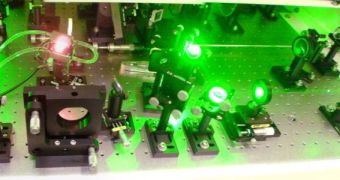Physicists from the Max Planck Institute of Quantum Optics (MPQ), in Garching, and chemists from the Ludwig-Maximilians-Universitat (LMU), in Munich, Germany, have recently managed to devise a new way of controlling single electrons inside complex molecules. Among swarms of other electrons, the team's method is able to identify the desired one, and then use ultra-short laser pulses, of only a few femtoseconds in duration, to influence its behavior. The full study appears in the September 1st online issue of the journal Physical Review Letters.
Electrons – negatively charged elementary particles – move extremely fast in single atoms and molecules. Their speed and movement can only be assessed at the attosecond scale, as in a billionth of a billionth of a normal second. The laser pulses that aim to influence them must therefore operate extremely well on the femtosecond scale. The instruments the German team, part of the Munich Center for Advanced Photonics (MAP), worked with are so fast that they can even function on the attoscale.
It is essential for electron control that the pulses and the speed of the particles are on the same scale. What the laser pulses basically do is generate strong electric and magnetic fields, which have the ability to influence the elementary particle directly and individually, in spite of the fact that a femtosecond laser pulse lasts 1,000 times more than an attosecond. While previous studies have demonstrated easy control methods of electrons in single-electron atoms, doing so in a more complex arrangement has proven to be a lot more difficult.
In the new experiments, the German researchers used carbon monoxide (CO) molecules. They generated an electric field waveform out of laser pulses, and managed to manipulate the actions of a single electron out of the cloud of 14 that the chemical had. With each extra elementary particle, the control becomes increasingly difficult, as the energy states of the electrons are closer and closer to each other. Visible, 740-nanometer laser pulses of four femtoseconds each were used to achieve manipulation.
“The collision produces an electronic wave packet which induces a directional movement of electrons along the molecular axis,” LMU Professor Regina de Vivie-Riedle explains. “The excitation and subsequent interaction with the remainder of the intense laser pulse leads to a coupling of electron and nuclear motion and gives a contribution to the observed asymmetry,” MPQ junior research group leader Dr. Matthias Kling adds.

 14 DAY TRIAL //
14 DAY TRIAL //